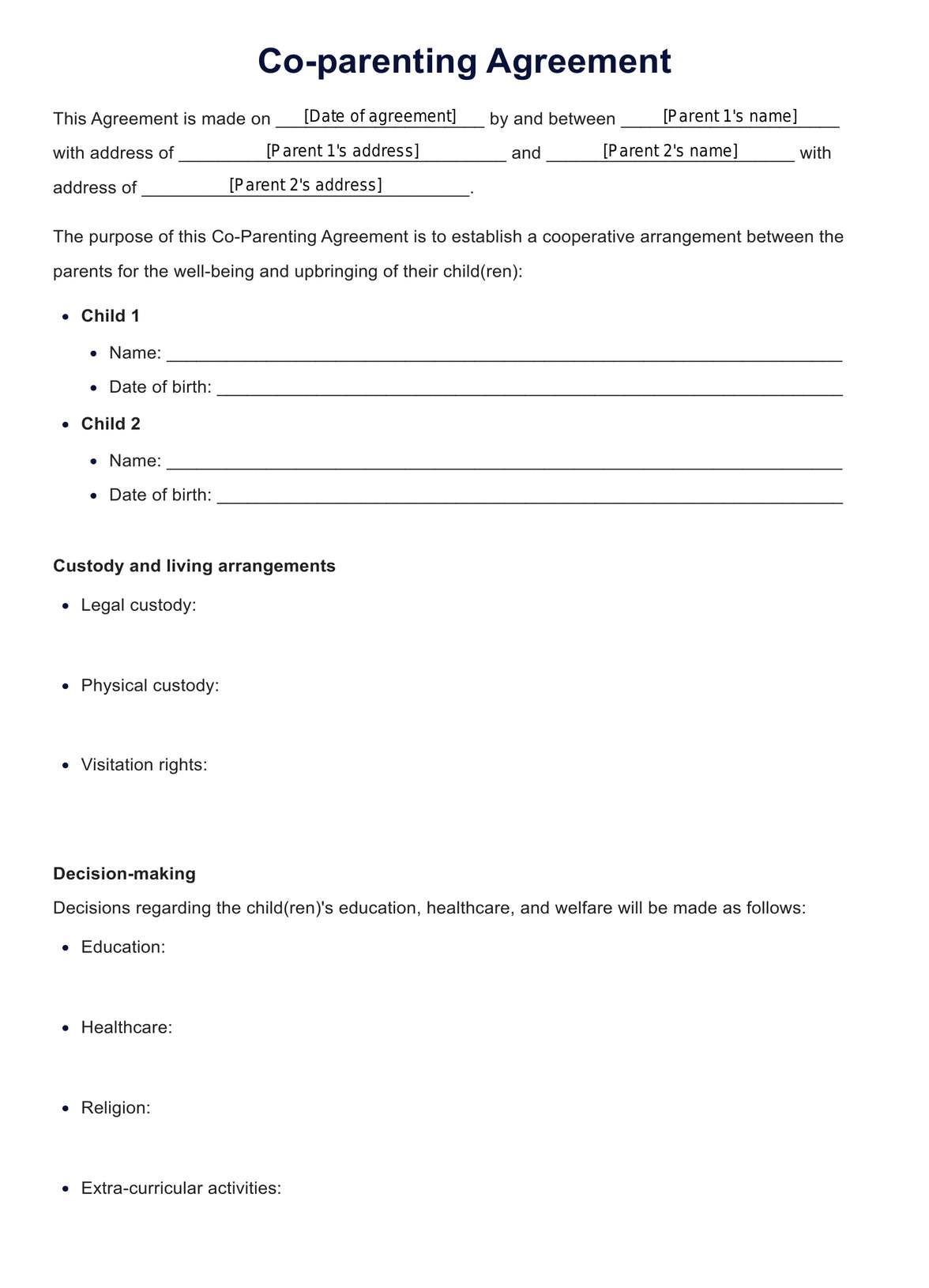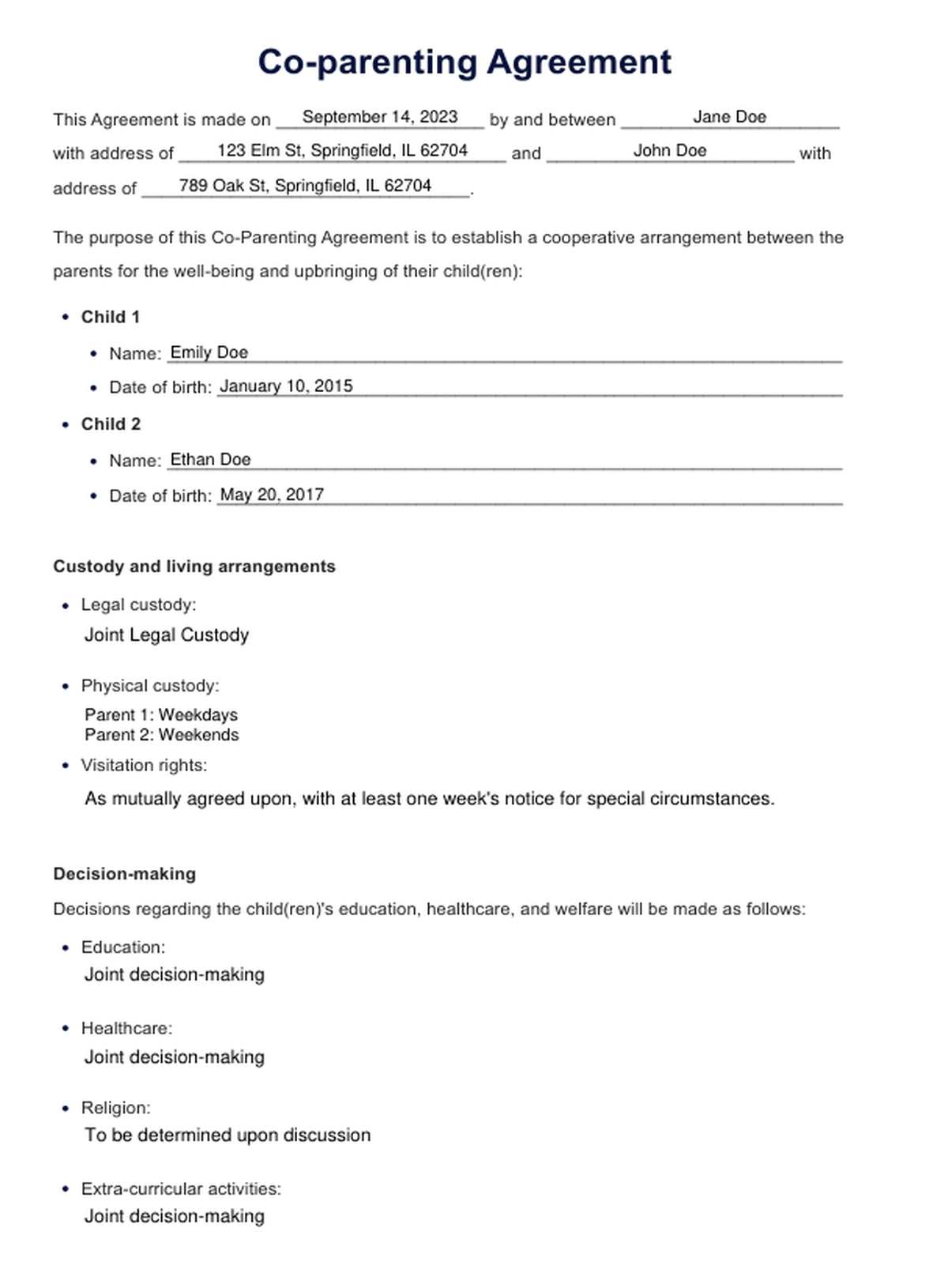-p-500.jpg)
Discover the benefits of using our free Co-Parenting Agreement Template. Streamline communication, reduce conflict, and focus on your child's best interests.
-p-500.jpg)
By Telita Montales on Jul 15, 2024.


Co-parenting agreements, or parenting plans, are legal documents that outline custody arrangements, visitation schedules, and parental responsibilities for children when their parents are separated or divorced. These agreements aim to provide stability and consistency for the children while ensuring that both parent’s rights and obligations are clearly defined (Braver & Lamb, 2018).
A co-parenting agreement is a comprehensive guide that addresses various aspects of raising children in separate households. It covers crucial elements such as legal and physical custody, parenting time schedules, a visitation schedule for the noncustodial parent, decision-making processes for important matters related to the child’s welfare, financial contributions (e.g., child support, medical insurance, children's education), and parental communication protocols.
PDF Template Example PDF

A comprehensive co-parenting agreement typically includes several key components that address various aspects of child custody, parental responsibilities, and parenting time schedules. These components are:
This section outlines the legal and physical custody arrangements, especially for a minor child. Legal custody refers to the parent’s right to make important child welfare decisions, such as education, religious upbringing, and healthcare. Physical custody determines the child’s primary residence and custody schedule. This also outlines existing agreements, especially if sole legal custody or joint legal custody exists.
The agreement details the specific parenting schedule, including the days and times when each parent will have primary physical custody of the child(ren). It may also include provisions for holidays, vacations, and special occasions, and visitation rights.
The agreement should outline each parent’s financial obligations to pay child support, financial support, medical insurance, and other expenses related to the child’s well-being.
This section specifies how the parents will make major decisions, including their decision-making authority, concerning the child’s life, such as education, the child’s healthcare, and extracurricular activities.
The agreement should outline the methods for communication between the parents and the procedures for resolving disputes or the dispute resolution process for modifying the agreement if necessary.
The Co-Parenting Agreement Template, whether it is this Co-Parenting Agreement Template or a parenting plan template, is designed to streamline the outlining of shared parenting responsibilities. Below are detailed steps on how to effectively utilize this resource:
Begin by downloading a printable co-parenting agreement template that meets your needs - whether it is this Co-Parenting Agreement Template, a Parenting Plan Template, or a Child Custody Agreement Template. Ensure the selected template covers all aspects of co-parenting and provides a comprehensive framework for your agreement.
Start filling out the template by including essential details such as the names of both parents, their contact information, and specific details about the child[ren], like their date of birth, school, health conditions (if any), etc. This section provides a foundational overview of the family structure.
Next, detail the type of custody arrangement—whether joint physical custody (shared between both parents) or sole physical custody (only one parent has primary responsibility). Specifying the residential schedule for the child(ren), including the custody schedule for weekdays, weekends, holiday schedule, and special occasions is crucial. This ensures clarity and prevents potential disagreements regarding time sharing especially for the non-custodial parent.
This step involves discussing and agreeing upon plans for vital aspects of the child's life. These include education plans, healthcare provisions, extracurricular activities, religious upbringing, etc. The goal is to ensure both parents contribute to decision-making processes that impact the child's development and well-being.
Establishing clear communication rules is vital for smooth coordination between co-parents. Decide upon preferred modes of communication (e.g., email, text, calls), frequency, and guidelines for discussing sensitive topics. This can significantly reduce misunderstandings and foster a healthier co-parenting relationship.
This parenting plan can be useful in various situations where parents are not living together but share the responsibility of raising their child(ren). Here are some common scenarios when a Co-Parenting Agreement Template might be beneficial: